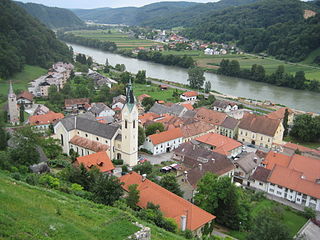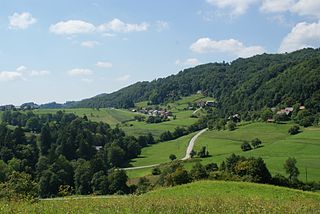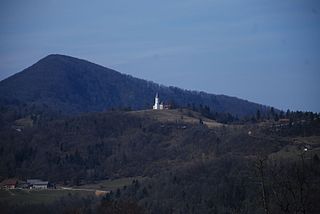| Trnovec | |
|---|---|
| Coordinates: 46°2′7.57″N15°22′50.59″E / 46.0354361°N 15.3807194°E Coordinates: 46°2′7.57″N15°22′50.59″E / 46.0354361°N 15.3807194°E | |
| Country | |
| Traditional region | Styria |
| Statistical region | Lower Sava |
| Municipality | Sevnica |
| Area | |
| • Total | 2.06 km2 (0.80 sq mi) |
| Elevation | 350.1 m (1,148.6 ft) |
| Population (2002) | |
| • Total | 140 |
| [1] | |
Trnovec (pronounced [təɾˈnɔːʋəts] or [təɾˈnoːʋəts] ) is a settlement in the hills northeast of Sevnica in east-central Slovenia. The area is part of the historical region of Styria. The Municipality of Sevnica is now included in the Lower Sava Statistical Region. [2]

Sevnica is a town on the left bank of the Sava River in central Slovenia. It is the seat of the Municipality of Sevnica. It is one of the three major settlements in the Lower Sava Valley. The old town of Sevnica lies beneath Sevnica Castle, which is perched on top of Castle Hill, while the new part of town stretches along the plain among the hills up the Sava Valley, forming another town core at the confluence of the Sevnična and Sava rivers.

Slovenia, officially the Republic of Slovenia, is a sovereign state located in southern Central Europe at a crossroads of important European cultural and trade routes. It is bordered by Italy to the west, Austria to the north, Hungary to the northeast, Croatia to the southeast, and the Adriatic Sea to the southwest. It covers 20,273 square kilometers (7,827 sq mi) and has a population of 2.07 million. One of the successor states of the former Yugoslavia, Slovenia is a parliamentary republic and a member of the United Nations, of the European Union, and of NATO. The capital and largest city is Ljubljana.

The Municipality of Sevnica is a municipality along the Sava and the Mirna Rivers in southeastern Slovenia. The seat of the municipality is the town of Sevnica. Today it is part of the Lower Sava Statistical Region. It is the 12th-largest municipality by area in Slovenia.
The local church, built in the northern part of the settlement, is dedicated to Saint George (Slovene : sveti Jurij) and belongs to the Parish of Sevnica. It originally dates to the 14th century with surviving traces of the original Gothic frescos despite major rebuilding in the 17th century. [3]

A church building or church house, often simply called a church, is a building used for Christian religious activities, particularly for Christian worship services. The term is often used by Christians to refer to the physical buildings where they worship, but it is sometimes used to refer to buildings of other religions. In traditional Christian architecture, the church is often arranged in the shape of a Christian cross. When viewed from plan view the longest part of a cross is represented by the aisle and the junction of the cross is located at the altar area.

Saint George was a soldier of Palestinian and Greek origins and a member of the Praetorian Guard for Roman emperor Diocletian, who was sentenced to death for refusing to recant his Christian faith. He became one of the most venerated saints and megalo-martyrs in Christianity, and was especially venerated by the Crusaders.

Slovene or Slovenian belongs to the group of South Slavic languages. It is spoken by approximately 2.5 million speakers worldwide, the majority of whom live in Slovenia. It is the first language of about 2.1 million Slovenian people and is one of the 24 official and working languages of the European Union.







